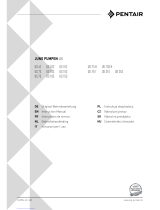
English (GB)
14
3.17 Installing a diaphragm pump
The diaphragm pump is optional.
1. Drill the outlet for the diaphragm pump. See
section 3.7 Drilling holes for the pipes.
2. Fit the DN 40 socket seal in the opening for the
diaphragm pump at the bottom of the tank. See
figures 21 and 22.
3. Insert the pipe from the diaphragm pump into the
outlet.
4. Secure the diaphragm pump and connect it to the
building outlet pipe according to the installation
and operating instructions of the pump.
3.18 Installing the controller
Mount the controller on a wall with screws through
the mounting holes of the back plate.
The cable entries must point downwards, and the
user interface must be easily accessible.
See the installation and operating instructions of the
controller.
3.19 Electrical connection
3.19.1 Connecting the pump
Connecting the pump to a power socket
1. Lead the pump cable through the cable gland.
2. Fit the power plug on the cable. A Schuko plug is
supplied with the product.
3. Insert the plug into a power socket.
Connecting the pump to a controller
1. Lead the pump cable through the cable gland.
2. Connect the pump cable to the controller. See the
wiring diagram supplied with the controller.
3.19.2 Connecting the level sensor hose to the
controller
Connect the level sensor hose to the pneumatic
entry in the bottom of the controller. The hose is
connected properly when it is pushed all the way in
and locked in position.
3.19.3 Connecting an alarm float switch to the
controller
1. Lead the cable of the float switch through one of
the M20 cable glands in the bottom of the
controller.
2. Connect the cable to the terminal for high-level
alarm. See the installation and operating
instructions of the controller.
3.20 Setting the controller before startup
LC 220
Select settings via the DIP switches. See the
installation and operating instructions of the
controller.
LC 221
You must set the start level and rated current of the
motor to be able to start the product. All other
settings are preset.
1. Close the isolating valves.
2. Set the selector switches on the controller to
"OFF".
3. Switch on the controller.
4. When the display shows "L_01", press [OK] to
enter the start level menu.
5. Select the start level using the left and right
arrows and press [OK]. See section 7.1.1 Setting
the start levels with a controller.
6. Go to the rated current menu "L_02" using the
left and right arrows and select the rated motor
current [A] according to the nameplate of the
pump motor.
You can change some factory settings. See the
installation and operating instructions of the
controller.
DANGER
Electric shock
Death or serious personal injury
- Before starting any work on the product,
make sure that the power supply has
been switched off and that it cannot be
accidentally switched on.
DANGER
Electric shock
Death or serious personal injury
- The protective earth (PE) of the power
outlet must be connected to the
protective earth of the product. The plug
must have the same PE connection
system as the power outlet.
DANGER
Electric shock
Death or serious personal injury
- The installation must be fitted with a
residual current device (RCD) with a
tripping current less than 30 mA.
DANGER
Electric shock
Death or serious personal injury
- The product must be connected to an
external main switch with a minimum
contact gap of 3 mm (0.12 inch) in all
poles.
LC 220 LC 221
QR98503252
QR98503253
http://net.grundfos.com/
qr/i/98503252
http://net.grundfos.com/
qr/i/98503253


























